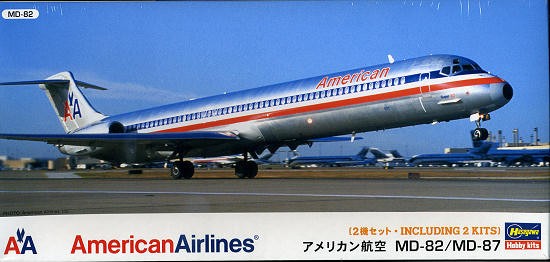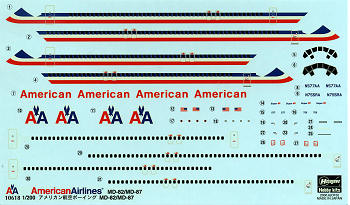
| KIT #: | 10618 |
| PRICE: | $22.98 at the LHS |
| DECALS: | Two options |
| REVIEWER: | Scott Van Aken |
| NOTES: | 2000 release. 2 complete kits |

| HISTORY |
The McDonnell Douglas MD-80 series are twin-engine, medium-range, single-aisle commercial jet airliners. The MD-80 aircraft were lengthened and updated from the DC-9. The MD-80 series can seat from 130 up to 172 passengers depending on variant and seating arrangement.
The MD-80 series was introduced into commercial service on October 10, 1980 by Swissair. The series includes the MD-81, MD-82, MD-83, MD-87, and MD-88. These all have the same fuselage length except the shortened MD-87. The MD-80 series was followed into service in modified form by the MD-90 in 1995 and the MD-95/Boeing 717 in 1999. Production of the 717 ceased in May 2006 after 156 were produced.
Douglas Aircraft developed the DC-9 in the 1960s as a short-range companion to their larger DC-8. The DC-9 was an all-new design, using two rear fuselage-mounted turbofan engines, and a T-tail. The DC-9 has a narrow-body fuselage design with 5-abreast seating, and holds 80 to 135 passengers depending on seating arrangement and aircraft version.
The MD-80 series was the second generation of the DC-9. It was originally called the DC-9-80 series and the DC-9 Super 80 and entered service in 1980.he DC-9 family is one of the most successful jet airliners with a total of over 2,400 units produced; it ranks third behind the second place Airbus A320 family with over 4,000 produced, and the first place Boeing 737 with over 6,000 produced.
| THE KIT |
 Hasegawa
really hit on something back about 30-40 years ago when it released the
first of its 'Love Liners' series. These were modern airliners in 1/200, a
scale that had not been used much for anything besides a few ships. Choosing
this over the more 'normal' 1/144 was planned as it would allow more
Japanese modelers to build airliners and have room to fit them in their
smaller homes. The initial range went from the 747 to the DC-9 with several
others in between. The results were such that these kits are still being
released today, though the subject has changed with the times.
Hasegawa
really hit on something back about 30-40 years ago when it released the
first of its 'Love Liners' series. These were modern airliners in 1/200, a
scale that had not been used much for anything besides a few ships. Choosing
this over the more 'normal' 1/144 was planned as it would allow more
Japanese modelers to build airliners and have room to fit them in their
smaller homes. The initial range went from the 747 to the DC-9 with several
others in between. The results were such that these kits are still being
released today, though the subject has changed with the times.  This is
a dual kit in that there is an MD-82 and an MD-87, both in American Airlines
livery. These differ only in the fuselage length and the upper fin so both
kits are nearly identical in how they build. The kit instructions show only
one build sequence with the different bits highlighted. Each kit is bagged
separately as Hasegawa does box these planes individually in most kits.
This is
a dual kit in that there is an MD-82 and an MD-87, both in American Airlines
livery. These differ only in the fuselage length and the upper fin so both
kits are nearly identical in how they build. The kit instructions show only
one build sequence with the different bits highlighted. Each kit is bagged
separately as Hasegawa does box these planes individually in most kits. | CONCLUSIONS |
If you like airliners, this one is a no brainer. With American still flying planes, this can be done as an example of current aircraft types. Its simple construction means that you'll have your models on a stand in record time.
| REFERENCES |
http://en.wikipedia.org/wiki/MD-87
February 2011
Thanks to me for espying this one on the shelf at the LHS.
If you would like your product reviewed fairly and quickly, please contact me or see other details in the Note to Contributors.